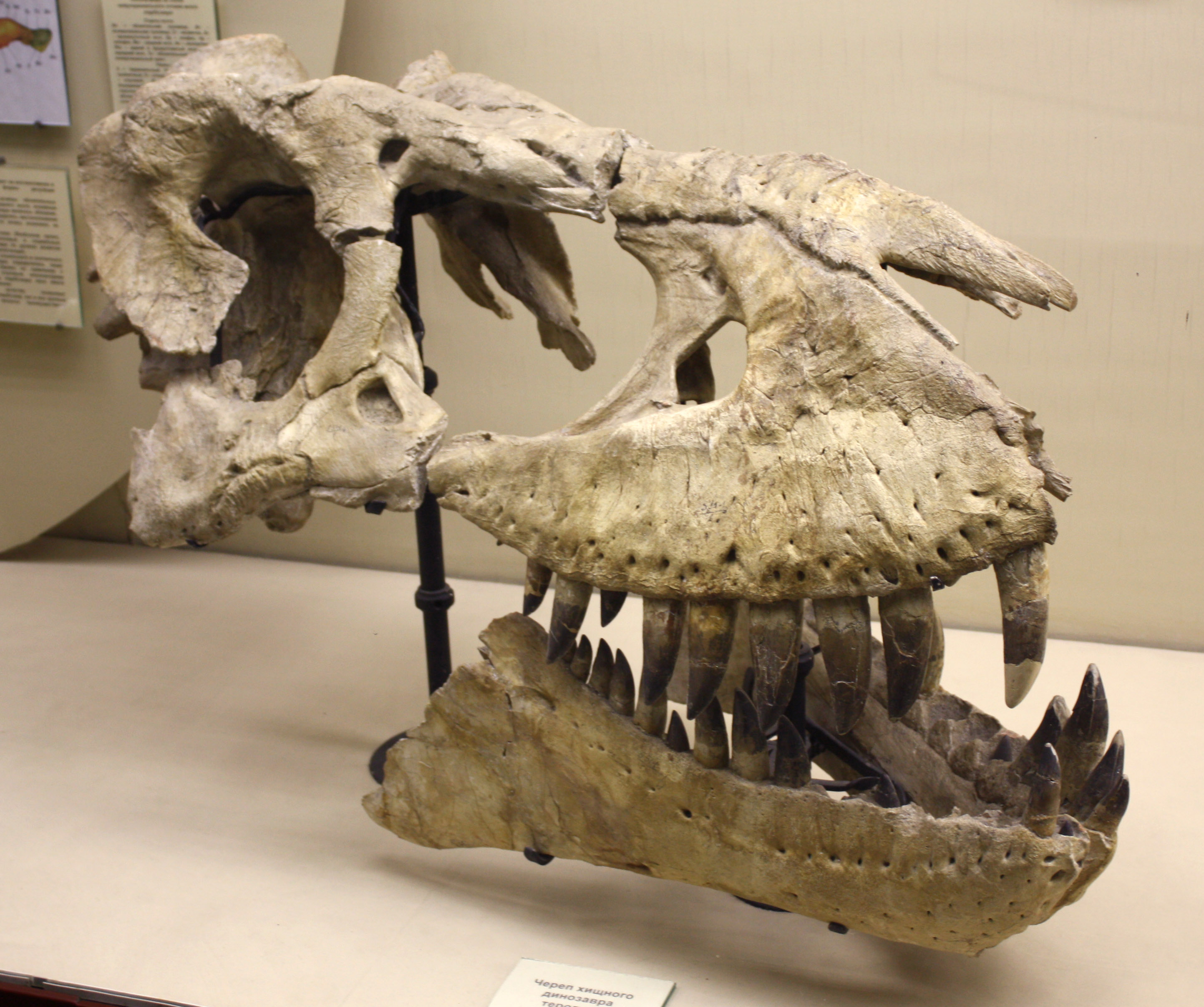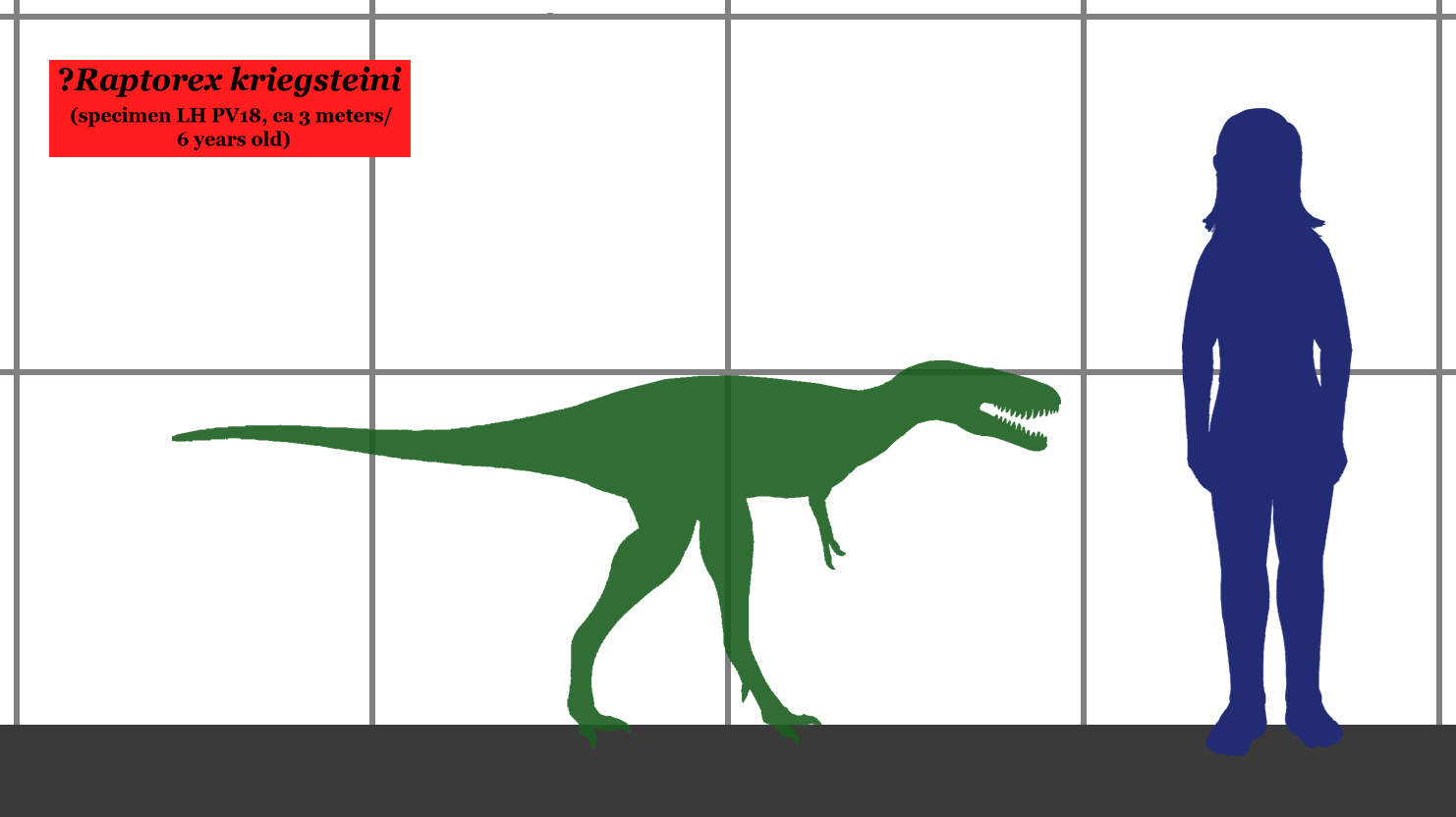|
Raptorex Kriegsteini
''Raptorex'' is a genus of tyrannosaurid dinosaur. Its fossil remains consist of a single juvenile specimen probably uncovered in Mongolia, or possibly northeastern China. The type species is ''R. kriegsteini'', described in 2009 by Sereno and colleagues. The genus name is derived from Latin ', "robber", and ', "king". The specific name honours Roman Kriegstein, a survivor of the Holocaust, whose son Henry Kriegstein donated the specimen to the University of Chicago for scientific study. While initially considered to have come from the Yixian Formation of China, dated to approximately 125 million years ago during the early Cretaceous period, later studies showed that such an early date for the fossil are unlikely, and given its extremely close similarity to juvenile tyrannosaurids of the late Cretaceous, it probably came from the Nemegt or similar formation. The specimen is a juvenile and many researchers now consider it to be a ''nomen dubium'', because the changes undergone b ... [...More Info...] [...Related Items...] OR: [Wikipedia] [Google] [Baidu] |
Late Cretaceous
The Late Cretaceous (100.5–66 Ma) is the more recent of two epochs into which the Cretaceous Period is divided in the geologic time scale. Rock strata from this epoch form the Upper Cretaceous Series. The Cretaceous is named after ''creta'', the Latin word for the white limestone known as chalk. The chalk of northern France and the white cliffs of south-eastern England date from the Cretaceous Period. Climate During the Late Cretaceous, the climate was warmer than present, although throughout the period a cooling trend is evident. The tropics became restricted to equatorial regions and northern latitudes experienced markedly more seasonal climatic conditions. Geography Due to plate tectonics, the Americas were gradually moving westward, causing the Atlantic Ocean to expand. The Western Interior Seaway divided North America into eastern and western halves; Appalachia and Laramidia. India maintained a northward course towards Asia. In the Southern Hemisphere, Aus ... [...More Info...] [...Related Items...] OR: [Wikipedia] [Google] [Baidu] |
Tarbosaurus Bataar
''Tarbosaurus'' ( ; meaning "alarming lizard") is a genus of large tyrannosaurid dinosaur that lived in Asia during the Late Cretaceous epoch, about 70 million years ago (Maastrichtian age). It contains the single type species: ''Tarbosaurus bataar'', which is known from the Nemegt Formation of Mongolia, with more fragmentary remains found further afield in the Subashi Formation of China. ''Tarbosaurus'' is represented by dozens of fossil specimens, including several complete skulls and skeletons. These remains have allowed studies focusing on its phylogeny, skull mechanics, and brain structure. Further fossil remains have been reported from other geologic formations of Asia, however, these remains are fragmentary and cannot be confidently assigned to ''Tarbosaurus'' or the type species. Like most known tyrannosaurids, ''Tarbosaurus'' was a large bipedal predator, with the type specimen measuring approximately long, tall at the hips, and weighing up to . It had a unique lock ... [...More Info...] [...Related Items...] OR: [Wikipedia] [Google] [Baidu] |
Harenaichthys
''Harenaichthys'' is an extinct genus of osteoglossiform fish that lived in Mongolia during the Late Cretaceous and was found in the Nemegt Formation. The type species is ''H. lui'' and is based solely on the holotype, which consists of partial skull parts, isolated and articulated centra, and an articulated caudal fin preserved together within a single sandstone block. The monospecific assemblages of ''Harenaichthys'' were affected by the high altitude of their habitat and the fossils show signs of pathologies caused by diseases while the animals were still alive. Kim ''et al.'' (2022) compared a fish centrum found with the holotype of the theropod dinosaur ''Raptorex ''Raptorex'' is a genus of tyrannosaurid dinosaur. Its fossil remains consist of a single juvenile specimen probably uncovered in Mongolia, or possibly northeastern China. The type species is ''R. kriegsteini'', described in 2009 by Sereno and ... kriegsteini'' with ''Harenaichthys lui'' and '' Xixiaichthys ... [...More Info...] [...Related Items...] OR: [Wikipedia] [Google] [Baidu] |
Holotype
A holotype (Latin: ''holotypus'') is a single physical example (or illustration) of an organism used when the species (or lower-ranked taxon) was formally described. It is either the single such physical example (or illustration) or one of several examples, but explicitly designated as the holotype. Under the International Code of Zoological Nomenclature (ICZN), a holotype is one of several kinds of name-bearing types. In the International Code of Nomenclature for algae, fungi, and plants (ICN) and ICZN, the definitions of types are similar in intent but not identical in terminology or underlying concept. For example, the holotype for the butterfly '' Plebejus idas longinus'' is a preserved specimen of that subspecies, held by the Museum of Comparative Zoology at Harvard University. In botany and mycology, an isotype is a duplicate of the holotype, generally pieces from the same individual plant or samples from the same genetic individual. A holotype is not necessarily "ty ... [...More Info...] [...Related Items...] OR: [Wikipedia] [Google] [Baidu] |
Hiodontidae
Hiodontidae, commonly called mooneyes, is a family (biology), family of Actinopterygii, ray-finned fish with a single monotypic, included genus ''Hiodon''. The genus comprise two extant species native to North America and three to five extinct species recorded from Paleocene to Eocene age fossils. They are large-eyed, fork-tailed fish that superficially resemble shads. The vernacular name comes from the metallic shine of their eyes. The higher classification of the mooneyes is not yet fully established. Some sources have place them in their own order, Hiodontiformes, while others retain them in the order Osteoglossiformes. Species *''Hiodon alosoides'' (Rafinesque, 1819) The goldeye, ''Hiodon alosoides'', is widespread across eastern North America, and is notable for a conspicuous golden Iris (anatomy), iris in the eyes. It prefers turbid slower-moving waters of lakes and rivers, where it feeds on a wide variety of organisms including insects, crustaceans, small fish, and moll ... [...More Info...] [...Related Items...] OR: [Wikipedia] [Google] [Baidu] |
Raptorex Vs Psittacosaurus
''Raptorex'' is a genus of tyrannosaurid dinosaur. Its fossil remains consist of a single juvenile specimen probably uncovered in Mongolia, or possibly northeastern China. The type species is ''R. kriegsteini'', described in 2009 by Sereno and colleagues. The genus name is derived from Latin ', "robber", and ', "king". The specific name honours Roman Kriegstein, a survivor of the Holocaust, whose son Henry Kriegstein donated the specimen to the University of Chicago for scientific study. While initially considered to have come from the Yixian Formation of China, dated to approximately 125 million years ago during the early Cretaceous period, later studies showed that such an early date for the fossil are unlikely, and given its extremely close similarity to juvenile tyrannosaurids of the late Cretaceous, it probably came from the Nemegt or similar formation. The specimen is a juvenile and many researchers now consider it to be a ''nomen dubium'', because the changes undergone b ... [...More Info...] [...Related Items...] OR: [Wikipedia] [Google] [Baidu] |
Ellimmichthyiformes
The Ellimmichthyiformes, also known as double-armored herrings, are an Extinction, extinct Order (biology), order of Actinopterygii, ray-finned fish known from the Early Cretaceous to the Oligocene. They were the sister group to the extant true herrings, Alosidae, shad and Anchovy, anchovies in the order Clupeiformes, with both orders belonging to the suborder Clupeomorpha. A highly successful group throughout the Cretaceous, they were found worldwide and are known to have inhabited both marine and freshwater habitats. They appear to have been a largely marine group for most of their history, with the first freshwater lineages appearing during the Late Cretaceous. Shortly after the origin of the Ellimmichthyiformes in the Early Cretaceous, the Mediterranean Sea, Mediterranean portion of the Tethys Ocean appears to have been a major center of diversification for them, as the majority of fossils of this group are known from there. Following this, they saw an explosion in diversity ... [...More Info...] [...Related Items...] OR: [Wikipedia] [Google] [Baidu] |
Black Hills Institute Of Geological Research, Inc
Black is a color that results from the absence or complete absorption of visible light. It is an achromatic color, without chroma, like white and grey. It is often used symbolically or figuratively to represent darkness.Eva Heller, ''Psychologie de la couleur – effets et symboliques'', pp. 105–26. Black and white have often been used to describe opposites such as good and evil, the Dark Ages versus the Age of Enlightenment, and night versus day. Since the Middle Ages, black has been the symbolic color of solemnity and authority, and for this reason it is still commonly worn by judges and magistrates. Black was one of the first colors used by artists in Neolithic cave paintings. It was used in ancient Egypt and Greece as the color of the underworld. In the Roman Empire, it became the color of mourning, and over the centuries it was frequently associated with death, evil, witches, and magic. In the 14th century, it was worn by royalty, clergy, judges, and government off ... [...More Info...] [...Related Items...] OR: [Wikipedia] [Google] [Baidu] |
Peter Larson
Peter Lars Larson (born 1952) is an American fossil dealer who is head of the Black Hills Institute of Geological Research, which specialises in the excavation and preparation of fossils. He led the team that excavated " Sue", one of the largest and most complete specimens of ''Tyrannosaurus rex'', which was the subject of a legal dispute resulting in its seizure and public auction. In 1996, Larson was convicted of customs violations related to failing to declare money he had brought from overseas, and served 18 months in prison. He has published scientific and popular works on dinosaur paleontology. Larson has been criticized by some paleontologists for his commercial enterprises and support of private collections. Education Peter Larson grew up on a ranch near Mission, South Dakota. He began rock hunting at the age of four on his parents' ranch. He attended the South Dakota School of Mines to study paleontology. He graduated with a bachelor's degree in 1974. Shortly after gr ... [...More Info...] [...Related Items...] OR: [Wikipedia] [Google] [Baidu] |
Raptorex Head
''Raptorex'' is a genus of tyrannosaurid dinosaur. Its fossil remains consist of a single juvenile specimen probably uncovered in Mongolia, or possibly northeastern China. The type species is ''R. kriegsteini'', described in 2009 by Sereno and colleagues. The genus name is derived from Latin ', "robber", and ', "king". The specific name honours Roman Kriegstein, a survivor of the Holocaust, whose son Henry Kriegstein donated the specimen to the University of Chicago for scientific study. While initially considered to have come from the Yixian Formation of China, dated to approximately 125 million years ago during the early Cretaceous period, later studies showed that such an early date for the fossil are unlikely, and given its extremely close similarity to juvenile tyrannosaurids of the late Cretaceous, it probably came from the Nemegt or similar formation. The specimen is a juvenile and many researchers now consider it to be a ''nomen dubium'', because the changes undergone b ... [...More Info...] [...Related Items...] OR: [Wikipedia] [Google] [Baidu] |
Tyrannosauroid
Tyrannosauroidea (meaning 'tyrant lizard forms') is a superfamily (or clade) of coelurosaurian theropod dinosaurs that includes the family Tyrannosauridae as well as more basal relatives. Tyrannosauroids lived on the Laurasian supercontinent beginning in the Jurassic Period. By the end of the Cretaceous Period, tyrannosauroids were the dominant large predators in the Northern Hemisphere, culminating in the gigantic ''Tyrannosaurus''. Fossils of tyrannosauroids have been recovered on what are now the continents of North America, Europe and Asia. If Megaraptora is part of Tyrannosauroidea, this would extend the distribution of the group to Australia and South America, and possible fragmentary remains of tyrannosauroids have also been reported from these continents. Tyrannosauroids were bipedal carnivores, as were most theropods, and were characterized by numerous skeletal features, especially of the skull and pelvis. Early in their existence, tyrannosauroids were small pr ... [...More Info...] [...Related Items...] OR: [Wikipedia] [Google] [Baidu] |








